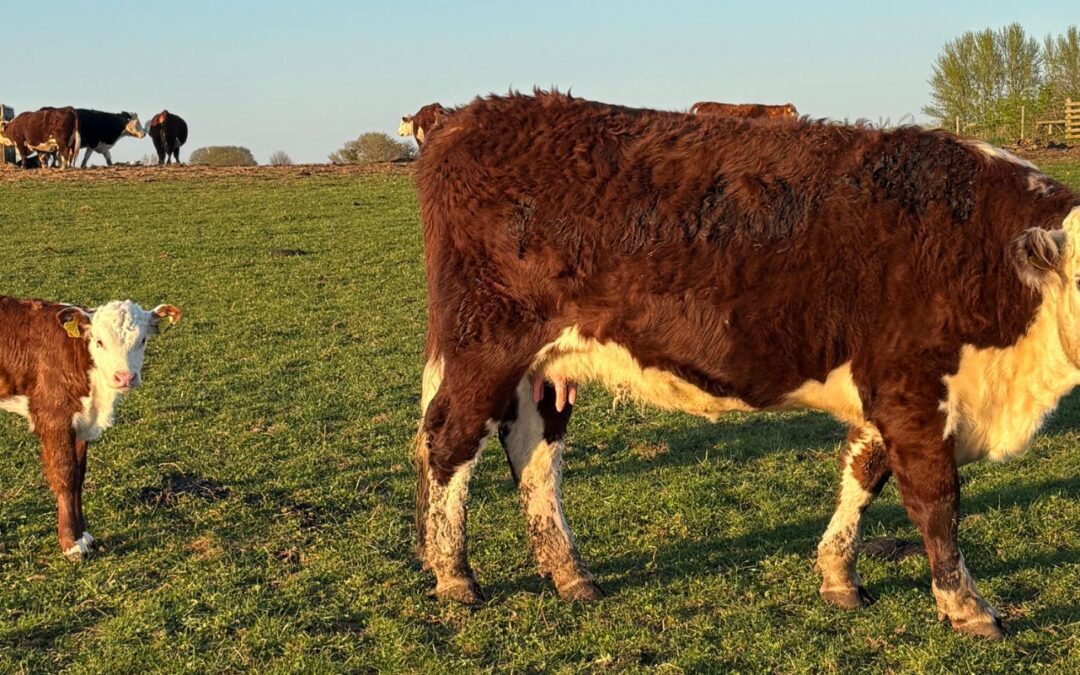A Bit About Our Cows
A few requests came back from my appeal for blog ideas the other week with the theme of how the business works behind the scenes. There’s always so much going on and I will endeavour to share it all through my musings! However, much of my attention at the moment is back on the farm, so that’s where I’ll start!
Yesterday, the cows were let out. For anyone with even a hint of farming knowledge, you’ll know this is a monumental day in the calendar. It marks the end of winter chores—the feeding, the mucking out, the endless bedding up that can feel relentless at times. Once the cows are out on grass, they pretty much take care of themselves: feeding, keeping clean, and only needing a quick daily check to make sure all’s well.
Our herd of suckler cows (the breeding females) actually stay out all year round. Being native breeds, they’re well accustomed to British winters. And although they might look a bit miserable now and again, they’re generally far better off outdoors, breathing in the fresh air, munching on hay, and keeping themselves to themselves.
The calves and yearlings (last year’s calves, now about a year old) are kept under cover in the barns over winter. This keeps them sheltered from the worst of the weather and allows us to feed them silage and keep a close eye on their growth. Then comes the big day—when they’re let out for the spring, summer, and autumn to graze the paddocks once again.
It’s been an extraordinary start to spring, weather-wise, which means we’ve been able to crack on with the spring fieldwork earlier than usual. This includes harrowing the grass to level out lumps and bumps, break up any muck left by the cows (or spread by us to fertilise the fields), and pull up dead grass and shallow-rooted weeds from last year. This gives the grass a proper wake-up call after its winter slumber and gets it primed for the growing season. Finally, we roll the ground to finish levelling it out and crush the crowns of the grass, which encourages it to ‘tiller out’ and spread across the soil.
Now that the soil has reached that magic temperature of around 8°C, the grass will start to grow. We’ll begin moving the cows between paddocks throughout the rest of the year. We leave about half the farm ungrazed until June, allowing the grasses, wild herbs, and legumes time to grow, flower, and seed (more on our farming principles here). Then, weather-dependent, we take a crop of hay or silage to stock up our supplies for next winter. After that cut, we move the cows over to that half of the farm and rest the bit they’ve just grazed—ready to repeat the cycle. With a kind summer (a good balance of sun and rain), we might get another crop of silage later in the season.
It’s a pretty hands-off system, really. We let nature do most of the work. The cows feed themselves, and in turn, they give back to the land—returning carbon and nutrients to the soil. The only really hands-on bit comes now, during calving season. Usually, our calves are born between March and early June. This year, however, our Hereford bull, Thistle, clearly had the wind in his sails nine months ago—we had half the cows calve in the space of one week. Naturally, that happened while I was away on holiday, leaving Mum, Dad, and Jake on maternity duty around the clock!
For the most part, the cows handle calving themselves, but we do get the odd complication—especially with heifers (first-time mums)—which might need a bit of careful attention and sometimes a helping hand.
This time of year is exactly what I dream of during the depths of winter to get me through. Lush green grass, clear blue skies, and cows and calves peacefully grazing the fields—just as they’ve done here on the farm for generations before me. It’s a blink-and-you’ll-miss-it moment, so make sure you soak it in on your next countryside walk. Or, better still, join me on one of our farm tours for our Day on the Farm event on the 14th of June!
